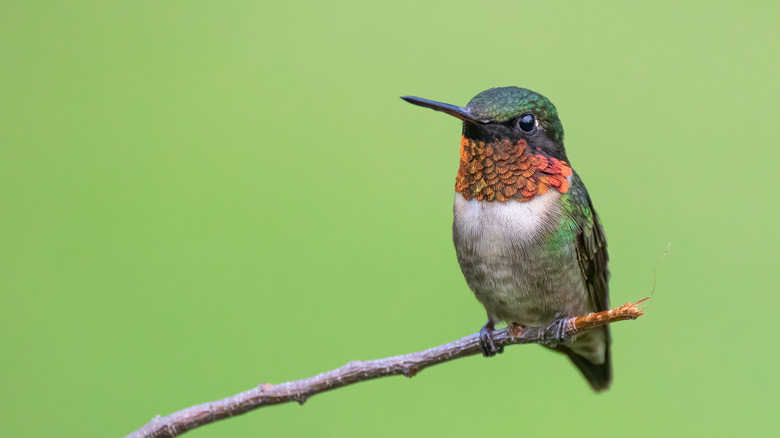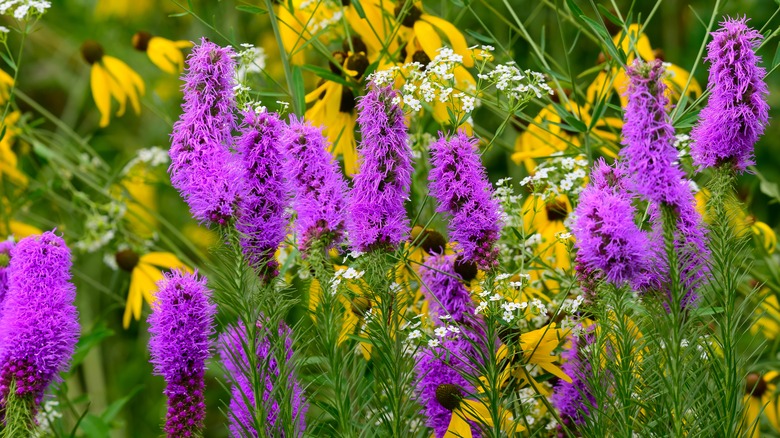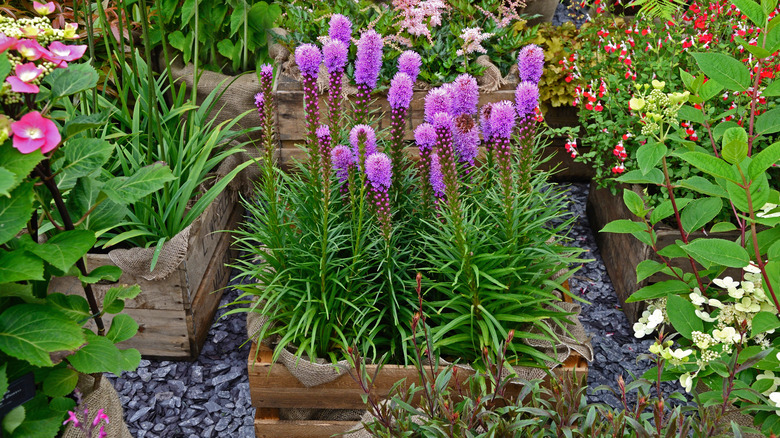Beautiful Varieties Of Blazing Star That Hummingbirds Will Love In Your Garden
Want to know why your hummingbird-friendly flower garden isn't working? It's probably because you haven't planted blazing star! (Okay, so there are other, more plausible reasons, but still blazing stars really do attract hummers in droves.) While there are dozens of blazing star species and cultivars, the plants appear on lots of hummingbird lists with just the common name "blazing star." This cover-all reference isn't really helpful and, in fact, makes things challenging for gardeners looking to find the best option to attract the wee winged gems to their garden. How do you know which of the many varieties to buy to suit your specific site?
Blazing star species all fall under the Liatris genus. These native perennials are found across North America (wild and cultivated) and are an important food and lifecycle plant for innumerable species of insects and birds, including the dainty hummingbird. The flowers hold lots of sweet treats for nectar lovers — bees, butterflies, and birds — through the summer, and later, the seeds feed other hungry avians. The most often discussed and sold species of this popular garden plant is dense blazing star (Liatris spicata). It's lovely, but there are other cultivars on the market worth exploring for helpful and unique characteristics. To help, we've narrowed the selection down by bloom color and growing conditions. For example, prairie blazing star boasts flowers in hues hummingbirds favor, dwarf blazing star (Liatris microcephala) is perfect for rock gardens, and Eastern blazing star (Liatris scariosa) doesn't mind some shade.
Blazing star cultivars in the vibrant bloom colors hummingbirds prefer
Red and hues on that spectrum, including orange, pink, and purple, are heralded as the colors you should add to the garden to help attract hummingbirds, though it's not entirely clear why. It could be because red is the easiest color to spot, other pollinators, like bees, avoid it, or that red blooming plants make their nectar more accessible. The rose-purple blooms of cattail or prairie blazing star (Liatris pycnostachya) act like 5-foot-tall signposts for hungry hummers. And the plant puts out these sugary wares up to the first frost. The blooms of rough blazing star (Liatris aspera) range from hot pink to reddish-purple to magenta — all shades hummingbirds are known to seek out. Like cattail blazing stars, they're also late bloomers, providing food into the fall.
Meadow blazing star (Liatris ligulistylis) is not only a vibrant bloomer, but it pairs well with other flowering prairie plants — think red salvia, big bluestem grass, and Engelmann's daisy — to create a hummer smorgasbord in your backyard. We recognize that not every gardener is a fan of such vibrant hues. If that's you, we're happy to inform you that blazing star flowers are so full of nectar that even the white-blooming blazing star varieties will attract hummingbirds. Liatris spicata Alba is a good (and easy to find) example. The plant can grow to an astonishing 6 feet tall, even in the wild, so it's hard for hummers to miss it.
Which blazing star variety will thrive best in your garden's unique conditions?
If you live in a drier part of the U.S. and don't get much rain or have quick-draining soils, consider scaly blazing star (Liatris squarrosa). It needs sun and sandy soils to grow lots of sweet lavender blooms for your feathered friends, and does best in clumps. If you're designing a rock garden, invest in dwarf blazing star (Liatris microcephala), which grows 2 feet high maximum, loves shallow, pebbly soil, and still has the signature showy, nectar-filled blooms. For boggy garden beds, try Liatris spicata 'Floristan White', which is less likely to complain about wet roots.
Savanna or Eastern blazing star (Liatris scariosa) tolerates quite a bit more shade than most of its genera, though it does still prefer dry conditions. Incidentally, it's another late bloomer; it will keep producing nectar-filled flowers into October. Voles love the roots, so if you're plagued by these wee beasties, perhaps reconsider. Container gardeners growing in pots on patios, porches, or balconies can choose Northern blazing star (Liatris novae-angliae). It's known for resilience in the often challenging conditions container gardens present. Many blazing star varieties need staking since their tall flower stems tend to droop if the plant's feet get their feet wet or get too much nitrogen-rich fertilizer. Lazy gardeners far from excited about the prospect of adding this task to their yard to-do list should pick up some Liatris spicata 'Kobold'. It rarely needs staking.


